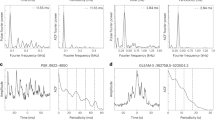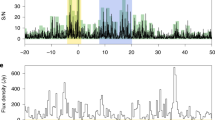Abstract
THE identity of pulsars with supernova remnants was indicated by the Vela X source1 and confirmed by the location of pulsar NP 0532 within the Crab Nebula2 and by observations of optical pulses from a central star3. It is probable that the source is a rotating, magnetic neutron star4,5. In concentrating on the pulsar we should not, however, overlook a second, equally significant problem in the case of the Crab. My purposes here are, first, to show that such a star may generate magnetic flux and energy and account for the large flux which exists within the nebula; second, to show that we now have almost direct observational evidence of conversion of gravitational to magnetic energy as required in radio galaxies and quasars; third, to propose an explanation of pulsars as omnidirectional pulsed signals excited by a rotating star.
This is a preview of subscription content, access via your institution
Access options
Subscribe to this journal
Receive 51 print issues and online access
$199.00 per year
only $3.90 per issue
Buy this article
- Purchase on Springer Link
- Instant access to full article PDF
Prices may be subject to local taxes which are calculated during checkout
Similar content being viewed by others
References
Large, M. I., Vaughan, A. E., and Mills, B. Y., Nature, 220, 340 (1968).
Comella, J. M., Craft, H. D., Lovelace, R. V. E., Sutton, J. M., and Tyler, G. L., Nature, 221, 453 (1969).
Cocke, W. J., Disney, M. J., and Taylor, D. J., Nature, 221, 525 (1969).
Pacini, F., Nature, 216, 567 (1967).
Gold, T., Nature, 221, 25 (1968).
Woltjer, L., Bull. Astron. Inst. Neth., 14, 39 (1958).
Oort, J. H., and Walraven, T., Bull. Astron. Inst. Neth., 12, 285 (1956).
Piddington, J. H., Austral. J. Phys., 10, 530 (1957).
Kulsrud, R. M., Bernstein, I. B., Kruskal, M., Fanucci, J., and Ness, N., Astrophys. J., 142, 491 (1965).
Duncan, J. C., Astrophys. J., 89, 482 (1939).
Trimble, V., Astron. J., 73, 535 (1968).
Clayton, D. D., and Craddock, W. L., Astrophys. J., 142, 189 (1965).
Piddington, J. H., Mon. Not. Roy. Astron. Soc., 133, 163 (1966).
Piddington, J. H., Planet. Space Sci., 15, 1625 (1967).
Alfvén, H., and Fälthammar, C.-G., Cosmical Electrodynamics, 64 (Oxford, 1963).
Bell, S. J., and Hewish, A., Nature, 213, 1214 (1967).
Bertotti, B., Cavaliere, A., and Pacini, F., Nature, 221, 624 (1969).
Radhakrishnan, V., Cooke, D. J., Komesaroff, M. M., and Morris, D., Nature, 221, 443 (1969).
Haymes, R. C., Ellis, D. V., Fishman, G. L., Kurfess, J. D., and Tucker, W. H., Astrophys. J., 151, L9 (1968).
Author information
Authors and Affiliations
Rights and permissions
About this article
Cite this article
PIDDINGTON, J. Pulsars and Magnetic Amplification. Nature 222, 965–966 (1969). https://doi.org/10.1038/222965a0
Received:
Issue Date:
DOI: https://doi.org/10.1038/222965a0
This article is cited by
-
The crab nebula
Astrophysics and Space Science (1973)
Comments
By submitting a comment you agree to abide by our Terms and Community Guidelines. If you find something abusive or that does not comply with our terms or guidelines please flag it as inappropriate.



